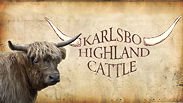Highland Cattle on vanha lehmärotu. Sen alkuperästä voidaan esittää monenmoisia arvailuja, mutta varmaa on ainakin se, että se on aikojen saatossa sopeutunut täydellisesti elämään Ylämaiden karussa ja koleassa luonnossa.
Tässä ote Highland Cattle Society´n sivuista:
The highland breed of cattle has a long and distinguished ancestry, not only in its homeland of western Scotland, but also in many far-flung parts of the world. One of Britain's oldest, most distinctive, and best known breeds, with a long, thick, flowing coat of rich hair and majestic sweeping horns, the Highlander has remained largely unchanged over the centuries. Written records go back to the 18th century and the Highland Cattle Herd Book, first published in 1885, lists pedigrees since that time. New folds, as herds of Highlanders are known, are founded every year both at home and abroad and in recent years Highland Cattle societies have been started in Sweden, Denmark, Austria, Germany, Holland, Finland, France, Switzerland and Norway and there are also Highlanders in Luxembourg, Belgium, the Czech Republic, Poland, and the Faroe Islands. In the British Isles folds are found from the furthest south to the extreme north on many different types of ground varying from the slopes of the Sussex Downs, the fenlands of East Anglia, to the windswept machars of the Outer Hebrides.
But it is on the vast areas of poor mountain land with high annual rainfall and bitter winds that Highland Cattle thrive and breed where no other cattle could exist Making the most of poor forage, calving outside and seldom, if ever, housed they make a real economic contribution to hill and upland areas.The breed is exceptionally hardy with a natural and unique ability to convert poor grazing efficiently. They are remarkable for their longevity: many Highland cows continue to breed to ages in excess of eighteen years having borne fifteen calves. They are great mothers. The versatility of the Highlander led to a great upsurge in exports to the USA, Canada, Australia, New Zealand, Norway, Sweden, Denmark, Finland, Germany, Austria, Holland and South America. Highland Cattle can be found foraging 10,000 feet up in the Andes.
Highland-nauta on erinomaisen säänkestävä. Joka on yksi syy siihen että ovat rantautuneet tänne Suomeenkin. Sen nahka on kaksi kertaa tavallisen naudan nahkaa paksumpi ja sillä on kaksinkertainen karvapeite: alempi, villava karva toimii lämpöeristeenä ja pidempi, karkea päällikarva sadetakkina.
Highlandit, kuten muutkin alkuperäisrodut, ovat harvoin sairaita. Highland-lehmän äidinvaisto on erittäin voimakas: vasikan syntyessä emo voi olla suorastaan vaarallinen pari ensimmäistä päivää. Emot huolehtivat myös yhdessä vasikoistaan.
Highland-lehmä oli skotlantilaisen vuokraviljelijän elinehto: se kykeni selviytymään ankarista talvista ja tuottamaan niukasta karkearehusta riittävästi maitoa vasikalleen ja viljelijän perheelle. Eläimestä laskettiin myös verta niukan ruokavalion täydentämiseksi, ja sarvet, karvat ja nahka käytettiin tarkkaan hyödyksi erilaisten tarvekalujen raaka-aineina. Highland-lehmä oli niin arvokas, että sitä käytettiin rahayksikkönä ja siten se aiheutti lukuisia riitoja ja kahakoita klaanien välillä.
Eläimet ovat edelleen melko hintavia, joten laadusta kannattaa varmistua jos on hankkimassa omaa Highland Cattle karjaa.
Osa tekstistä lainattu HCC- yhdistyksen sivuilta.



Kommentit